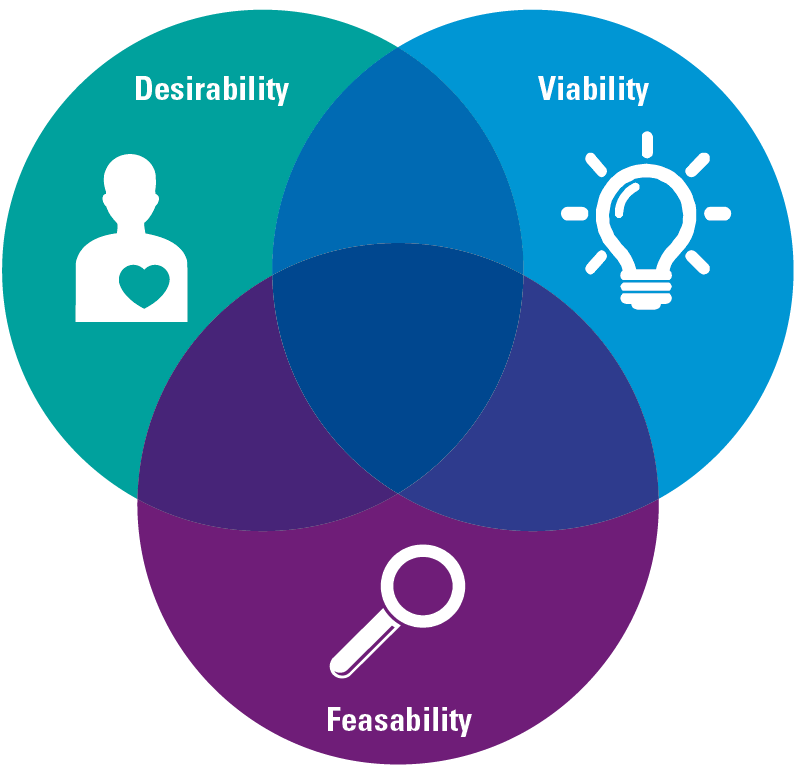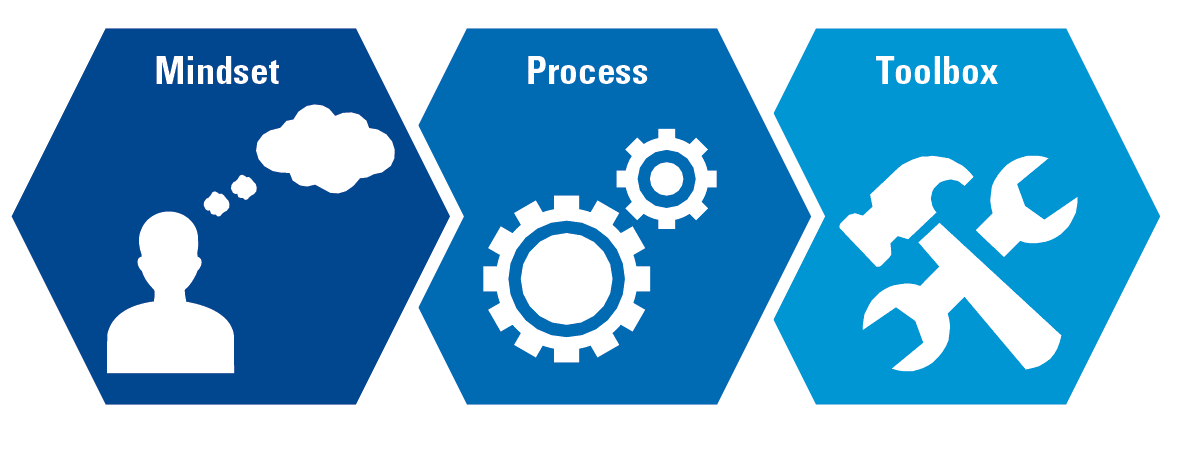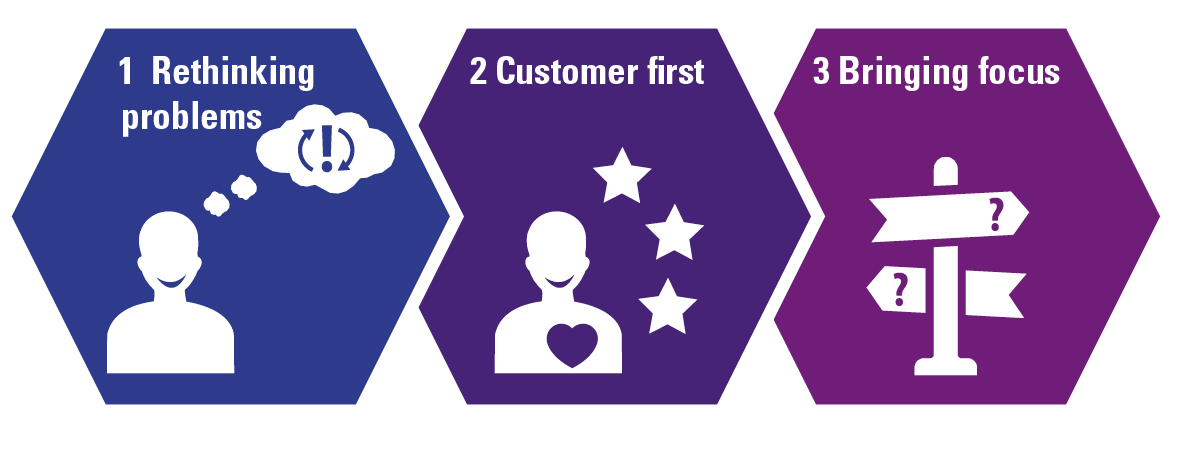Design Thinking is buzzing in the market. Especially in the context of the creation of new digital products and solutions, Design Thinking has been getting more and more attention, and its use has not been limited to customer-centric or high-tech companies like Airbnb and Google. This is not surprising, given the fact that design-driven companies structurally outperform their non-design-driven peers, as illustrated by research carried out by McKinsey ([Shep18]). We believe Design Thinking can really make a difference in any sector, especially in the exciting digital era we are in today.
What is Design Thinking? First of all, there are many ways to explain and understand and apply Design Thinking, some more on-point and effective than others, and none of them tells the whole story. First and foremost: Design Thinking is an approach that helps with the balancing act of creating products, services and solutions that are desirable for people, viable for the business and strategy and technologically feasible. Whereby desirability for people is always the starting point.
Following that, we believe that there are three dimensions to Design Thinking that pretty much cover the spectrum of its application:
- Mindset: The Design Thinking mindset is the glue of Design Thinking. Without it, the use of tools and processes becomes way less effective, if not ineffective (in some cases). First of all, the mindset should be empathic: focusing on understanding your users and their actual needs. It is also optimistic: in Design Thinking you think in opportunities, build on each other’s thoughts and ideas (divergence), and synthesize these into a common understanding. Lastly, it is experimental: you learn by doing, using probes and prototypes to come to new understandings of human needs.
- Process: We divide Design Thinking into five phases: Discover, Define, Ideate, Experiment and Evaluate ([Roel22b]). The process serves as a handhold in Design Thinking, but it is very important to note that learning-by-doing, customization of the process and loads and loads of iterations, make applying Design Thinking highly non-linear.
- Toolbox: There are tons of available tools that fit the mindset and support the process (coming from the world of Design Thinking, lean start-up, Agile, or UX design, etc.). So you can start experimenting with several tools right away. But the effectivity of using them is partly dependent on when, how and with what mindset you use them. Some tools fit specific challenges/stages of the process better than others. An example can be during experimentation; creating a prototype can be done on paper (low fidelity) or online as a clickable mockup (high fidelity), the choice highly depends on how far you are in the experimentation phase.
KPMG applies these three dimensions of Design Thinking in many client engagements. An example is a redesign of an external dashboard for a governmental organization, where the focus has been on the specific target groups (citizens, journalist, members of parliament). The end goal of this dashboard is to improve and restore trust in IT projects within the government. Based on a citizen panel (with qualitative and quantitative research methods) and a large number of interviews, personas were created. These gave clear insights into the drivers and motivation of the different target group who would use this dashboard. Based on these personas many ideas and designs were created, first on paper and after more iterations they became more advanced and clickable. These prototypes help in getting feedback and iterate many times to find a solution that is fitting for different target groups.
NS as a service organization uses Design Thinking, for example, to improve the traveler experience. That means the way travelers experience their train ride, but also the interaction with (digital) touchpoints and providing travel information. NS researches its travelers and their behaviors and needs based on data (quantitative), but also by observing travelers in stations or when travelling from A to B (qualitative). Years of research resulted in need-driven profiles of travelers (similar to personas) that are used to create empathy for the people that travel, but also to base decisions on with regards to new products or services. Prototyping and getting feedback from travelers come in various forms at NS, ranging from testing out new functionalities within the NS app, creating a new concept based on traveler’s information and providing other means of transportation to get from A to B, to developing the interior of a new train. In the end, everything is about the traveler.
You may already have noticed that a wide variety of interpretations and applications of Design Thinking are possible, but specifically companies that start a Digital Transformation can benefit from applying the Design Thinking mindset and its tools. Design Thinking will not magically make all your struggles around your digital transformation go away, but it will add value in three ways to your Digital Transformation:
1 Rethinking problems
People love thinking and talking about solutions. The reactions when you are telling someone that you can’t focus in your open-plan office or that you want to automate a part of your customer contact center may respectively be “You should buy this awesome new pair of noise cancelling ear buds!”, or “Have you considered implementing a chatbot?”. These could be great solutions to your problems, but then again, they also couldn’t. There is a big chance that you haven’t mentioned your underlying problem – because why should you? You yourself may not even know the underlying need, or how to formulate it. Apart from the explicit needs you might have for less noise in the office, there are underlying needs called tacit and latent needs. Discovering and defining them is an important part of Design Thinking, because that is where you can really make a difference with customer-centric solutions. Since digital transformation is all about getting value from your digital possibilities, the question is: who and what are we transforming for? It is not about the solutions in the first place, but about the problems. Therefore: fall in love with the problems, not the solutions!
This starts by not taking the problem for granted (which would allow you to rush towards the comfortable realms of coming up with solutions). In Design Thinking, you empathize with your users/customers and really try to dig deep into their problems. Tools like personas and empathy maps allow you to discover the underlying needs of your users (divergence) and define the needs of users that need addressing (convergence). This allows you to adapt to changing conditions, driving change that sticks, in your digital transformation.
2 Customer first
It is often said that we live in the age of the customer . What this means, is that customers nowadays are more informed than ever before and are more aware of their options. A great customer experience is one of the most important differentiating assets of a company in the digital era ([Roel22a]). It therefore makes sense that it is included in most companies’ corporate strategies, in one way or another. Failing to put the customer first ([Roel16]) – be it by not meeting their needs in your product offering, in the way you interact with them, or by focusing on solely creating business value and pushing technology – will result in customers going elsewhere.
Always having the customer in mind when starting digital initiatives is therefore very important. This is not limited to digital initiatives regarding new product or service offerings, or client-facing applications or channels. Even when transforming back-office processes your customers might be impacted, because in the end your employees have an important role in offering a great customer experience.
While most companies have customer-centricity as one of their main priorities, in practice this is easier said than done. One way to get information about your customers is by collecting and analyzing tons of their data. Quantitative analyses can definitely help to measure how people react to (new) products and services, but it often doesn’t help to understand “why” customers make certain choices. This makes quantitative research more suitable for the evaluation phase of Design Thinking.
Design Thinking primarily focuses on the gathering and analysis of qualitative data. Putting your customers first is, in all about truly understanding your customers by empathizing with them. Tools from ethnographic research, storytelling methods, customer journey mapping, empathy maps, and personas help to do this. Using insights gathered with these tools empowers employees ([Hern20]) to really understand the customers and create customer-centric products, services or processes.
3 Bringing focus
As digital possibilities are everywhere, it can be hard to define where to focus your digitization efforts. Sounding both logical and enticing, the ‘let a 100 flowers bloom’ approach has been popular for starting a digital transformation. In this approach it is reasoned that if you just start lots of digital initiatives, at least some of them should return value in the future. In practice, this approach often results in an uncoordinated proliferation of initiatives, which often do not go further than the idea phase due to a lack of attention and funding. That does not mean that crowdsourcing a problem within your company, as part of an innovation challenge, is bad practice in digital transformation. As mentioned, we believe divergence is one of the key principles of the Design Thinking mindset and the power of your people will help you to generate options and find creative ideas. However, in order to use the right focus, there are two very important things to always bear in mind:
- Always start with the problem. As already mentioned earlier, Design Thinking is all about empathizing with your user – be it a customer or even an employee – and understanding their problems and needs. Focus on real problems that actually need solving, and not on some nice potential solution.
- After divergence, comes convergence. Endless cycles of diverging and converging. Convergence is usually painful. It is the point where teams start fighting because it turned out that they have different understandings of their user’s problem. It is also the point where people have to painfully kill their darlings, their million-dollar ideas, simply because choices need to be made and other ideas turned out to be a better fit to the needs of the user and will deliver more value in the end.
Design Thinking tools can help you explore and define what really matters to your users and support teams in focusing on the right products and services for these users, which will help you to define your digital roadmap, including the technologies that might support this journey. The KPMG Pillars of Customer Experience ([KPMG22]) can help you define your future customer journey and the experience that comes with this. With a Design Thinking approach, which helps you to translate this future experience into concrete opportunities and technologies, a roadmap as part of your Digital Strategy can be built.
Conclusion
Design Thinking adds value to your digital transformation in three ways: firstly, it helps to rethink problems, to ensure your solutions solve the right problems; secondly, it helps you to always put the customer first, which is a key strategic differentiator in the age of the customer; and finally, it helps you to focus on the right problems, solutions and technologies, which can again help you to set up your digital roadmap.
As we mentioned earlier, those who venture into a digital journey will face many challenges, and Design Thinking isn’t going to help with all of them. However, by applying Design Thinking in our collaborations with clients, we have already experienced how the Design Thinking mindset and tools can support a digital transformation, focusing the efforts of you and your colleagues, and accelerating the right change in a more customer-centric way ([Sund19]).
References
[Hern20] Hernandez, J. et al. (2020). Making the connection: Employee experience drives customer experience. KPMG. Retrieved from: https://advisory.kpmg.us/content/dam/advisory/en/pdfs/2020/making-connection-employee-customer-experience.pdf
[KPMG22] KPMG (2022). The Six Pillars of Experience. Retrieved from: https://home.kpmg/nl/en/home/insights/2021/11/the-six-pillars-of-experience.html
[Roel16] Roelofs, J. & Cheung, L.Y. (2016). Customer centricity: Het creëren van een customer-centric organisatie. Compact, 2016(4). Retrieved from: https://www.compact.nl/articles/customer-centricity
[Roel22a] Roelofs, J., Hoogendijk, C. & Tjew-A-Sin, V. (2022). Are you customer-centric in name only? Compact, 2022(4). Retrieved from: https://www.compact.nl/articles/are-you-customer-centric-in-name-only/
[Roel22b] Roelofs, J. (2022, February 23). Zet je klant centraal met Design Thinking. KPMG Nederland. Retrieved from: https://home.kpmg/nl/nl/home/insights/2022/02/zet-je-klant-centraal-met-design-thinking.html
[Shep18] Sheppard, B., Sarrazin, H., Kouyoumjian, G., & Dore, F. (2018, October 25). The business value of design. McKinsey Quarterly. Retrieved from: https://www.mckinsey.com/capabilities/mckinsey-design/our-insights/the-business-value-of-design
[Sund19] Sundaram, M. (2019). Design is not ‘nice-to-have’: Exploring good design and the business value of improving design capabilities within your organization. Compact, 2019(2). Retrieved from: https://www.compact.nl/articles/design-is-not-nice-to-have








